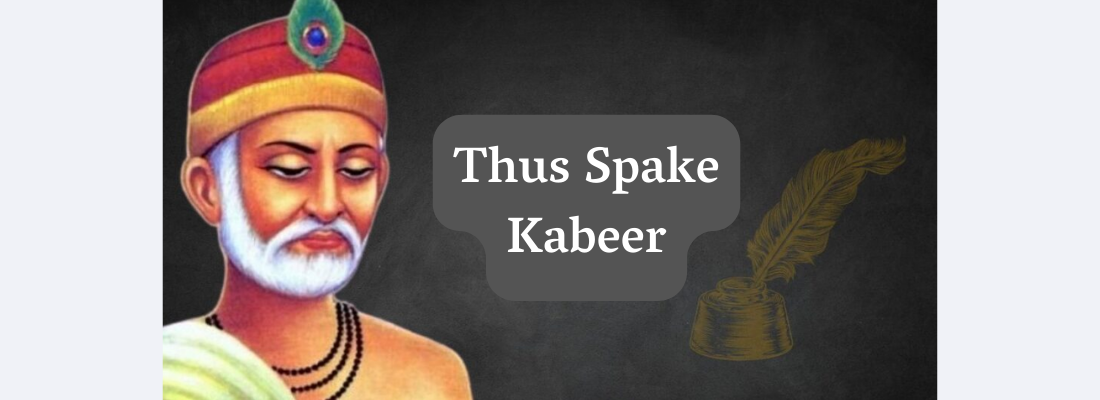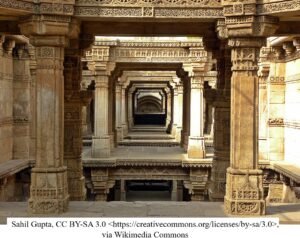Kabeerdaas ji is categorized as a saint but his thoughts and compositions are not confined to religion, spirituality, meditation and bhajans alone. He also deals with worldly life – the character and behaviour of individuals; practices (and malpractices) rampant in society; evils of caste system which divides people into ‘high’ and ‘low’ classes, etc. He also goes in depth in denouncing superstitions and hypocrisy prevalent in practice of religions and sects in general. He considers them as obstructions in the way of health, peace and happiness of society. We should take all these things into account if we want to understand and interpret Kabeer’s poetry correctly.
— Kusum Banthia
गुरु गोविंद दोऊ खड़े, काके लागूँ पाय ।
बलिहारी गुरु आपने, गोविंद दियो बताय ।।
Guru Govind douu khade, kaake laagoon paaya
Balihaarii Guru aapane, Gocind diyo bataaya
Kabeerdaas ji gives a lot of importance to guru. The creature comes into the world and wanders in the web spread by Maya. He does not know his true Brahman form nor the path to salvation from Maya. Sometimes he does not even realize that he is wandering on the wrong path. A guru is a wise person who makes him aware of this situation and shows him the right path of liberation. In this couplet, Kabeerdass ji imagines a situation when both Guru and Govind, i.e. Paramatma, are standing in front of him. They have a dilemma in their minds as to whom to bow down first. Guru is a worldly being and God is the supreme element whom the Guru worships. In this situation, due to the guru being worshiped, one should first bow down to God. But Kabeerdass ji first bows to the Guru and goes to his sacrifice – expressing gratitude to him, because without a Guru, he would not have even known the way to reach God. It is the Guru who awakens the sleeping soul and shows it the path of liberation by making him aware of his true nature.
Note:
The point to note is that he is using the name ‘Govind’ for God. In many other couplets, he has used the names of incarnations like ‘Rama’, ‘Murari’ etc. for Brahma, but he does not mean these incarnations but the formless Nirgun Brahma.

यह तन विष की बेलरी, गुरु अमृत की खान ।
सीस दिए जो गुरु मिले, तो भी सस्ता जान ।।
Yah tan vish kii belarii, Guru amrut kii khaan
Sees diye jo Guru mile, to bhii sanstaa jaan
In this couplet, Kabeerdaas ji likens the human body to a poisonous vine. Just as poison harms a man and destroys his life, vices like attachment, greed, lust, desire etc., distract him from the path of true happiness and liberation of soul and thus destroy his life. These vices grow and spread and entangle him like a vine. They are associated with his earthly life and human body. That is why the poet has called his body a poisonous vine. Guru, on the other hand, is a storehouse of nectar, according to Kabeerdass ji. Just as nectar has the power to eliminate the effect of poison and brings the dead back to life, the teachings and guidance of guru have the power to lead a person trapped in vices to the path of righteousness. In this way, the person comes to realise his inherent divinity and is ready to attain eternal bliss. That is why Kabeerdass ji holds guru in highest esteem and values him more than life itself. If we get a guru even at the cost of our lives, we should consider it a profitable deal.

-
Thus Spake Kabeer 01
Kabeerdaas ji is categorized as a saint but his thoughts and compositions are not confined to religion, spirituality, meditation and bhajans alone. He also deals with worldly life – the character and behaviour of individuals; practices (and malpractices) rampant in society; evils of caste system which divides people into ‘high’ and ‘low’ classes, etc. He…
-
Thus Spake Kabeer 02
Kabeerdaas ji is categorized as a saint but his thoughts and compositions are not confined to religion, spirituality, meditation and bhajans alone. He also deals with worldly life – the character and behaviour of individuals; practices (and malpractices) rampant in society; evils of caste system which divides people into ‘high’ and ‘low’ classes, etc. He…
-
Thus Spake Kabeer 03
Kabeerdaas ji is categorized as a saint but his thoughts and compositions are not confined to religion, spirituality, meditation and bhajans alone. He also deals with worldly life – the character and behaviour of individuals; practices (and malpractices) rampant in society; evils of caste system which divides people into ‘high’ and ‘low’ classes, etc. He…


